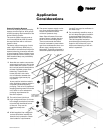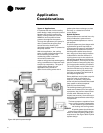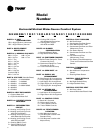
WSHP-PRC001-EN 31
The performance standard ARI/ISO
13256-1 became effective Jan. 1, 2000.
It replaces ARI standards 320, 325 and
330. This new standard has three ma-
jor categories: Water Loop (ARI 320),
Ground Water (ARI 325), Ground Loop
(ARI 330). Although these standards
are similar there are some differences.
The cooling efficiency is measured in
EER but includes a Watt-per-Watt unit
of measure similar to the traditional
COP measurement.
The entering water temperature has
changed to reflect the centigrade tem-
perature scale. For instance the water
loop heating test is performed with
68-degree F (20-degree C) water in-
stead of 70-degree F. The cooling tests
are performed with 80.6-degree F
(27-degree C) dry bulb and 66.2-de-
gree F (19-degree C) wet bulb entering
air instead of the traditional 80-degree
F dry bulb, and 67-degree F wet bulb
entering air temperatures. This data
(80.6/66.2) may be converted to 80/67
by using the entering air correction ta-
ble.
A pump power correction has been
added onto the existing power con-
sumption. Within each model, only
one water flow rate is specified for
each performance category, and
pumping watts are calculated utilizing
the pump power correction formula:
(gpm x 0.0631) x press drop x 2990) /
300.
Note: gpm relates to water flow, and
press drop relates to the drop through
the unit heat exchanger at rated water
flow in feet of head.
The fan power is corrected to zero ex-
ternal static pressure. The nominal air-
flow is rated at a specific external
static pressure. This effectively reduc-
es the power consumption of the unit,
and increases cooling capacity but de-
creases heating capacity. These watts
are significant enough in most cases
to increase EER and COP over ARI 320,
325, and 330 ratings.
Cooling Dominated
Applications
If humidity levels are moderate to high
in a cooling dominated application,
the heat pump should be selected to
meet or exceed the calculated sensible
load. Also, the unit’s sensible capacity
should be no more than 115% of the
total cooling load (sensible + latent),
unless the calculated latent load is less
than the latent capacity of the unit.
The sensible-to-total cooling ratio can
be adjusted with airflow. If the airflow
is lowered, the unit latent capacity will
increase. When less air is pulled
across the DX coil, more moisture will
condense from the air.
Heating Dominated
Applications
Unit sizing in heating dominated appli-
cations is based upon humidity levels
for the climate, and goals for operating
cost and installation costs.
If humidity levels are moderate, the
heat pump should be selected with the
heating capacity equal to 125% of the
cooling load.
If humidity levels are low in the appli-
cation and low operating cost is im-
portant, the heat pump and ground
loop should be sized for 90% to 100%
of the heating load.
If humidity levels are low and lower
initial cost is important, then the heat
pump and ground loop should be
sized for 70% to 85% of the heating
load, with the remaining load to be
treated with electric resistance heat.
Installation cost will be reduced in this
approach because of the smaller heat
pump selection and less loop materi-
als.
In general, the system will not use
enough electric heat to offset the high-
er installation costs associated with a
fully sized or oversized system.
Finally, a unit sized for the entire heat-
ing load in a heating dominated appli-
cation will be oversized in cooling.
Comfort is reduced from increased
room humidity caused by short-run
times. Short cycling will also shorten
the life expectancy of the equipment
and increase power consumption and
operating cost.
Many rebate incentives require the
heat pump and ground loop to be
sized for the entire heating load. Check
with you local utility for their require-
ments.
Selection Program
All WSHP products should be selected
through the Trane Official Product Se-
lection System, TOPSS.
If this program has not been made
available, ask a local Trane sales engi-
neer to supply the desired selections
or provide a copy of the program.
Required Fields
The first step in the selection is to de-
termine either:
Total cooling capacity
Sensible capacity
Heating capacity
The maximum allowable water pres-
sure drop and selection ranges can
also be identified.
Selection
Procedure


















